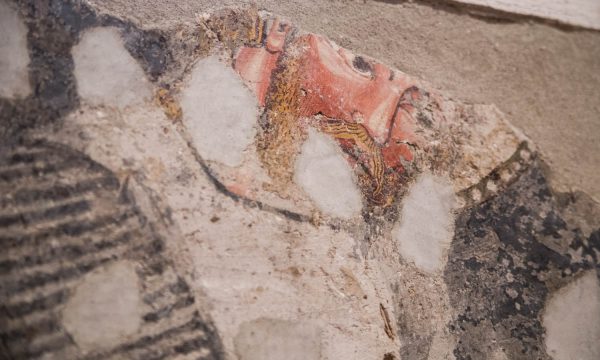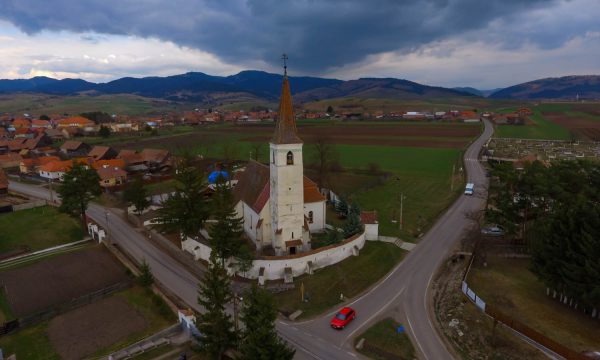Wall painting
The settlement and church were mentioned in 1332 as S. Michaele. The chancel of the early church was demolished in the 15th century and replaced with a polygonal chancel having the same width as the nave and closed with three sides of an octagon. The tower was probably also built at this time, and was raised further in 1715. The precinct wall with loop-holes was probably built in the 17th century. In 1819 a large annex was attached to the nave from the south, thus the mediaeval wall was almost completely destroyed here.

Mediaeval figural paintings are known to exist only on the northern wall of the nave. In spite of its fragmentation, it is a remarkable work of high quality. Its significance is enhanced by the fact that these frescoes are the works of the same master who painted the church of Dârjiu (Hu: Székelyderzs) in 1419. Jolán Balogh’s observations were confirmed by the recently discovered details. According to our knowledge, the frescoes surfaced in the 1930s during a repair and painting work, thus they are the result of a non-professional uncovering. The Calvary depiction found in the lower register, at the centre of the wall surface, is the largest intact surface. Only the face of Christ was destroyed, respectively the feet are degraded due to the high moisture content of the masonry. The characteristic motifs of the background – very similar to the ones in Dârjiu – are clearly visible everywhere. In the upper register some smaller fragments of the Saint Ladislaus legend have survived, but here, due to the opening of a new window and the rendering of its surroundings, the painted surface is highly fragmentary. Behind the gallery parapet the front legs and saddle of Saint Ladislaus’ horse, as well as the holy king’s armoured foot are visible. On the right side of the window, research has revealed the lower frame of the painting, cut off Cuman heads and hands, as well as bloody Cuman hats. The technique, the colour scheme, and the materials used in the painting carried out in an excellent a fresco technique are the same as in the case of the paintings in Dârjiu.

According to Balázs Orbán, around the mid-1800s the following inscription could still be read on the tower: SantI LaDisLaS RegIs VngarorUm honor /1715/. Today, only the painted wave scroll running under the moulding can be seen, which is the same as the decoration visible in the attic of the southern annex of the Roman Catholic church in Racu (Hu: Csíkrákos), where this layer covers a 16th century façade painting by Péter Zabya.
Natural Heritage
A large portion of the surrounding areas belongs to the Ciuc Mountains (Hu: Csíki-havasok) and Ciuc Basin (Hu: Csíki-medence) nature reserves. Between Mihăileni and its southern neighbour, Frumoasa (Hu: Szépvíz), runs the small creek of Cibre, which marks the border between the two localities. All along the mountain creek grow a variety of willows, Mayday trees (Prunus padus, also known as bird cherry or hackberry) and common alders (Alnus incana). During the spring, a colourful flower carpet covers the banks. This includes the endemic Hepatica transsilvanica, only found in the Carpathians, the European wild ginger (Asarum europaeum), an evergreen with wine coloured flowers in the springtime, the wood anemoe (Anemone nemorosa), with its white, and the yellow anemone (Anemone ranunculoides), with its yellow flowers.

There are ponds remnant from the ice age on the hilltop, not far from the creek, with very rich wildlife. The smooth newt (Triturus vulgaris) and the northern crested newt (Triturus cristatus), the tadpoles of the European common frog (Rana temporaria), dragonfly larvae and water fleas live in them. The northern crested newt is a protected species; its members can live for up to ten years. The female carefully wraps each individual egg in submerged aquatic plants, which, considering it lays 200–300 eggs, is no small feat. One of the plants that live in these waters is the Utricularia vulgaris, a carnivorous bladderwort species, which feeds on small crabs and microscopic animals.
On the higher altitudes, if we are patient, we can glimpse the various birds of the pine forests. The large Ural owl (Strix uralensis) spends its days resting on the branches, while the Eurasian pygmy owl, the smallest owl species in Europe, is active by day, and can be sighted sitting on the very top of the pine trees.
